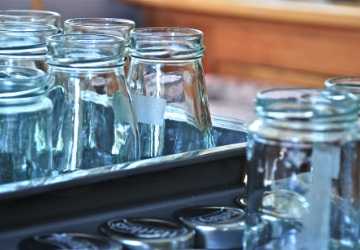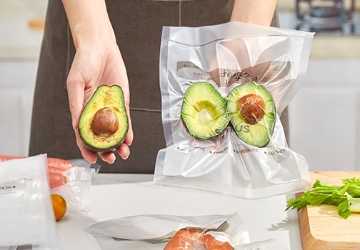Even the most adept home preservers can occasionally make food preservation errors. Ensuring safe home food preservation hinges on recognizing ubiquitous pitfalls and mastering how to prevent them. This guide elucidates prevalent issues and proffers practical remedies.
Inadequate Sterilization of Jars
Insufficient sterilization of jars is a frequent food preservation error. This step is paramount to ensuring the safety of preserved food.
How to Avoid It:
- Consistently commence with pristine, heated jars.
- Sterilize jars in boiling water for no less than 10 minutes.
- Utilize a sterile, dry cloth to handle jars to obviate contamination.

Inexactitude in Processing Times
Another recurrent blunder is not adhering to precise processing times. This can result in under-processed victuals, which can be perilous.
How to Avoid It:
- Conform to reliable recipes that specify exact processing times.
- Employ a chronometer to ensure the correct duration.
- Adjust processing times for altitude as necessitated.
Neglecting to Vent the Pressure Canner
Properly venting the pressure canner is indispensable to expunge air and attain the correct pressure.
How to Avoid It:
- Heed the manufacturer’s instructions for venting the canner.
- Allow vapor to escape for at least 10 minutes before sealing.
- Scrutinize the pressure throughout the procedure.
Utilizing Inferior Produce
Employing bruised or overly mature produce can vitiate the quality and safety of your preserved food.
How to Avoid It:
- Select fresh, high-quality produce for preservation.
- Discard any fruits or vegetables exhibiting signs of spoilage.
- Lavate is produced meticulously before use.
Erroneous Storage Conditions
Storing preserved food in improper conditions can precipitate spoilage or foodborne maladies.
How to Avoid It:
- Store jars in a cool, tenebrous, and arid environment to avoid preservation mistakes.
- Avoid storing near calorific sources or in direct solar exposure.
- Periodically inspect seals to ensure Safe home food preservation.
Overlooking the Cooling Process
Properly allowing jars to cool post-processing is a frequently overlooked step in safe home food preservation.
How to Avoid It:
- Position jars on a towel or rack to cool after processing.
- Allow them to cool undisturbed for 12-24 hours.
- Inspect seals after cooling and reprocess or refrigerate any unsealed jars.
Neglecting to Label Jars
Failure to label jars can engender confusion regarding the contents and processing dates, complicating the tracking of shelf life.
How to Avoid It:
- Label jars with the contents and the date of preservation.
- Utilize waterproof labels or markers.
- Organize jars by date to use the oldest first.
Overfilling or Underfilling Jars
Incorrect fill levels can cause jars to not seal properly or lead to spoilage.
How to Avoid It:
- Leave the recommended headspace as specified in the recipe.
- Wipe rims clean before sealing.
- Ensure lids are centered and apply rings with just the right tension.
Skipping the Boiling Water Bath for High-Acid Foods
High-acid foods like fruits and pickles necessitate a boiling water bath to ensure safety.
How to Avoid It:
- Process high-acid foods in a boiling water bath for the time specified in the recipe.
- Utilize a pot sufficiently deep to cover jars with at least one inch of water.
- Commence timing once the water returns to a vigorous boil.
Using Antiquated or Unreliable Recipes
Employing archaic or unverified recipes can lead to food preservation errors that compromise safety.
How to Avoid It:
- Utilize up-to-date, vetted recipes from reliable sources.
- Eschew improvising or altering recipes, especially with processing times or ingredients.
- Consult trusted food preservation manuals or websites for safe home food preservation.
Using Incorrect Equipment
Employing unsuitable apparatus can culminate in egregious food preservation errors that undermine both safety and integrity.
How to Avoid It:
- Utilize apparatus specifically engineered for food preservation.
- Ascertain all apparatus is in optimal operational condition and meticulously calibrated.
- Expediently replace any deteriorated or defective instruments.
Overlooking the Importance of pH Levels
Neglecting to evaluate the pH levels of comestibles can precipitate hazardous preservation practices.
How to Avoid It:
- Utilize pH indicators or meters to ascertain the acidity of your victuals.
- Adhere to recipes that stipulate precise pH levels for preservation.
- Amend pH levels as required by incorporating acidulants such as citric acid or acetic acid.
Ignoring Sanitation Practices
Neglecting stringent sanitation protocols can introduce contaminants into your preserved comestibles, resulting in spoilage or pathology.
How to Avoid It:
- Sustain an immaculate workspace, encompassing countertops, utensils, and hands.
- Sterilize all apparatus and surfaces antecedent. Avoid preservation mistakes.
- Forestall cross-contamination by segregating raw and preserved foods.
Using Improper Seals
Deficient sealing of jars can permit air and microorganisms to infiltrate, precipitating spoilage.
How to Avoid It:
- Utilize new, undamaged lids and bands for each preservation session.
- Ensure lids are centered and rings are applied with precise tension.
- Assess seals post-cooling and reprocess any jars that do not seal appropriately.

Misunderstanding Water Activity
Failing to modulate water activity in preserved comestibles can precipitate microbial proliferation and spoilage.
How to Avoid It:
- Comprehend the concept of water activity and its pertinence in food preservation.
- Employ desiccation methods, salts, and sugars to regulate water activity in preserved comestibles avoiding preservation mistakes.
- Conform to guidelines delineating the appropriate water activity levels for various preserved foods.
Overcomplicating Recipes
Incorporating superfluous steps or ingredients can introduce hazards and food preservation errors.
How to Avoid It:
- Adhere to simple, validated recipes that you are proficient with.
- Refrain from improvising or appending extraneous steps that are not recommended.
- Concentrate on mastering rudimentary techniques prior to endeavoring more complex recipes.
Neglecting to Pre-Heat Canning Lids
Bypassing the pre-heating of canning lids can result in an inadequate seal.
How to Avoid It:
- Pre-heat canning lids in simmering water in accordance with manufacturer instructions.
- Eschew boiling lids, as this can impair the sealing compound.
- Apply lids while they are still warm to ensure a proper seal.
Failing to Ventilate the Storage Area
How to Avoid It:
- Ensure your storage area is well-ventilated to avert moisture accumulation.
- Avoid storing jars in damp or enclosed spaces.
- Regularly inspect the storage area for indications of mould or moisture and rectify issues promptly, avoiding preservation mistakes.
Conclusion
Avoiding preservation mistakes is crucial for ensuring the safety and quality of your preserved foods. By adhering to these guidelines, you can practice safe home food preservation and relish the fruits of your labor for months to come. Remember, meticulous attention to detail and adherence to proper techniques are pivotal in avoiding food preservation errors and ensuring your preserved foods remain safe and delectable.
